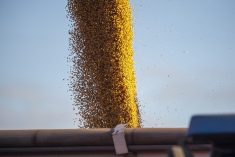Buenos Aires | Reuters — Argentina’s current wheat crop benefited from significant rainfall that fell over southern parts of the country’s agricultural area at the weekend, the Rosario Grains Exchange (BCR) said in a report on Monday.
Agricultural powerhouse Argentina is a major global supplier of wheat and corn, as well as of processed soybeans.
October overall saw abundant precipitation over the South American nation’s main grains-growing area. However, southern portions of Buenos Aires province farmland were drier until last weekend. They now show improved soil moisture levels.
Read Also

U.S. grains: Soy hits four-month high on hopes for China trade deal
U.S. soybean futures jumped to their highest level in more than four months on Monday on hopes that China will resume buying American supplies after President Donald Trump said the countries were set to reach a trade deal during his trip to Asia this week.
“We are seeing that the rains have helped a region that had been left out,” said Cristian Russo, the head of the BCR’s crop forecasts unit, in the report.
He cited “very good” rainfall benefiting wheat in particular, noting that parts of Buenos Aires province saw up to 2.7 inches (70 millimeters) of rainfall.
The 2024/25 wheat harvesting season begins this month and is expected to yield 19.5 million metric tons, according to the BCR’s latest forecast.
The recent rainfall is also expected to boost soybean and corn plantings in the 2024/25 cycle, according to the report.
— Reporting by Maximilian Heath












